Ready to learn Data Science? Browse Data Science Training and Certification courses developed by industry thought leaders and Experfy in Harvard Innovation Lab.
Roles in analytics and picking up the skills to become ‘priceless’
Every aspirant in data science has the question “What skills do I need to enter the industry?”, closely followed by “How do I become highly sought after in this job market?” While the industry is hot with a skewed demand-supply that’s in favour of trained professionals, getting the mix of skills right is not easy.
Now it’s common knowledge that ‘data scientist is the sexiest job of the century’. But what role does this exactly refer to? The very mention of this title conjures up images of math wizards sweating it out in multivariate calculus and linear algebra, or of geeks coding to create the next general artificial intelligence.
And then, one is also thrusted upon with busy venn diagrams that call for mastery of a laundry list of skills. These add up to areas that a team of people may have mastered amongst them, over years. Data scientist is a loosely used term, a title that’s heavily abused in the industry. Quite like Big Data or, say AI.
In practice, the title is often used as an umbrella term for related roles and is variously interpreted by companies in the industry. I’ve come across many people who’ve confessed to me in private, “Give me any job and role, but please coin me a job title with some play of these 2 words — ‘data’ and ‘scientist’!

Photo by frank mckenna on Unsplash
So, what does it take to enter and succeed in Data science?
Fuelled by such confusions, people wonder whether they must learn programming to have a go at a career in data science. For others, statistics or machine learning may not be their cup of tea. These then appear to be stumbling blocks for making any advances into the analytics field.
This particularly perplexes laterals who have developed an interest in data, but, say have 10 years in an unrelated role, in a different industry. The assumption of having to learn coding or design afresh to restart their career stumps them. These misconceptions must be forcefully put to rest, lest they continue crushing dreams of a career in data science.
So, what’s a realistic expectation on the skills needed to make a career in data science? And, can aspirants pick and choose skills of interest to carve out a preferred role, one that builds on strengths, while also being in demand?
Yes!
We’ll first present the spectrum of skills that are needed in data science, like a buffet menu. Then we’ll construct the key industry roles that deliver analytics value, by picking and choosing from amongst these skills, like a customised meal. And yes, we’ll also unwrap the secret sauce to becoming a unicorn in this industry.

A buffet menu of Data science Skills (Photo by Dan Gold on Unsplash)
The spectrum of Skills in Data science
There are 5 skills that are central to data science. To emphasise this again, no, one doesn’t need to learn them all. We’ll cover the roles and the mix of skills that each role entails, in the next section. First, lets talk about the complete listing of competencies needed in a project, in order to deliver business value.
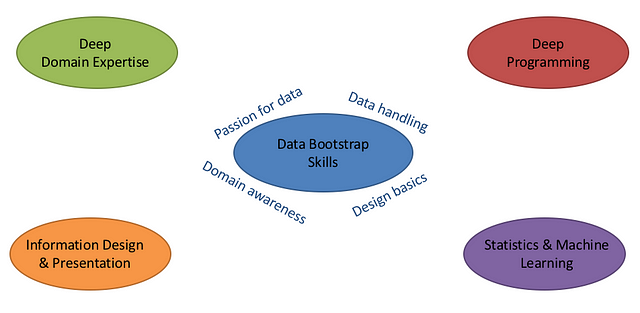
Spectrum of the key data science skills
1. Data Bootstrap skills
Passion for numbers is a pre-condition for success in data science, and a great asset. One must pickup data wrangling skills to get a feel for data — compute averages, fit cross tabs and extract basic insights through exploratory analysis. It’s the approach that matters and any tool, say Excel, R or SQL will do.
Insights from analysis and results of data techniques are like an unpolished diamond. They are valuable to a trained eye, but worthless in a marketplace. Its invaluable to pickup the presentation and basic design skills to polish those nuggets of insights. This makes one’s efforts effective and worthwhile.
Data handling and basic design must be topped up with a good orientation of a chosen domain. Techniques with data are only as good as their adaptation to a business problem. This basic knowledge can’t be outsourced to a business analyst, so anyone serious about data science should pickup domain basics.
In short, this skill requires one to befriend data and train their eyes to spot patterns in numbers. This is a fundamental skill that is non-negotiable in analytics.
2. Information Design and Presentation
Information design is the presentation of data in a way that fosters effective and efficient understanding. The emphasis is on visual design that enables consumption of data, rather than just beautification. Visualisation is that last mile of communication that enables users to get value from analytics.
To become an expert in this area, one must master the design skills spanning the realms of interaction design, user experience and data visualisation. This calls for expertise in user mapping, information architecture, data representation, wire framing, high fidelity design and visual aesthetics.
The greatest value of a picture is when it forces us to notice what we never expected to see — John Tukey
3. Statistics and Machine learning
In most data science courses, this area is devoted a lion’s share of attention. The focus here is on statistics and modelling, while scripting or programming is a secondary skill. While this is a key area for extraction of value from data, an over-emphasis here may take focus off the other 4 key skills in data science.
Building upon the basic data wrangling skills, one must dive in deeper into statistics, probability and then branch out into the techniques and algorithms in machine learning. Deep learning and other trending AI techniques fall into this bucket as well, but these call for more extensive coding skills.
4. Deep programming
People with a core programming background have great use in data science, and it’s not mandatory for them to pickup machine learning skills. Data applications call for backend coding to connect and handle data, need heavy lifting with data processing and building out internals of data science apps.
There are also strong needs for front-end coding skills to showcase the data insights to users, which is where the rubber really meets the road. One must master processing and presentation of data onto a variety of UI and form factors. Languages like Python, Java, Javascript, R, SQL are popular.
5. Domain expertise
Deep domain skills help bring in meaning, interpretability and actionability to analytics. The importance of blending domain expertise with data skills cannot be overemphasised. Lack of sufficient attention in this area throughout a project is the most common cause of failure for initiatives.
Picking up depth in a chosen domain and mastering the business flows is the first step here. One must then focus on data-literacy and a conceptual understanding of analytical techniques. This brings in the know-how to weave a tight fabric by combining domain skills with data chops, for superior value.
“If you do not know how to ask the right question, you discover nothing. — W. Edward Deming”
The Roles in Data science

Roles in data science — making oneself a customised meal (Photo by Brooke Lark on Unsplash)
Now that we’ve seen the spread of skills, these combine to form the following 4 core roles in analytics. These roles can be found in every shop that is serious about data science offerings. They are usually carved out as separate roles as described here, or are blended into some overlapping combinations.
Given the evolving state of the industry, the job designations are fairly fluid. While we’ve seen that ‘data scientist’ is a loosely used title often to attract talent, what a role like ‘Data ninja’ may mean is anybody’s guess! Here, I’ve used titles closer to those we’ve evolved over the past 7 years, at Gramener.
1. Data science Engineer or Specialist

Data science Engineer or Specialist — Skill mix
Folks who combine the data bootstrap skills with deep programming (front-end, back-end or full-stack) fall under this title. These roles are critical in application programming, integration and cloud implementations of data science applications. Apart from deep coding skills, this calls for mastery in processing data, automating insights and end-to-end app implementations. Some organisations show data scientist as a senior role in this career path.
2. Data Analyst
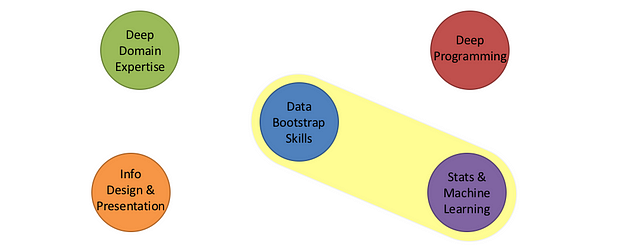
Data analyst — Skill mix
These are people who top up the core data chops with skills in statistics and machine learning. While they are the authority in devising analytics approach and building out models, they leverage their basic programming skills and domain orientation to implement and evaluate model interpretability.
3. Information Designer or Visualization Designer
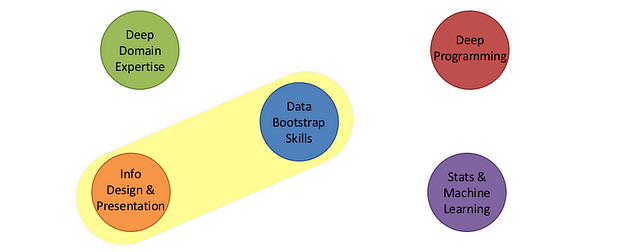
Information designer or Visualisation — Skill mix
Designers with core UI and UX skills, who also bring in a strong grounding in fundamental data skills fit the bill of Information Designer. They play an important role from conceptualisation to creation of data stories. Keeping users at the centre of the universe, they iteratively drive design of the visual intelligence layer.
4. Functional Data Consultant
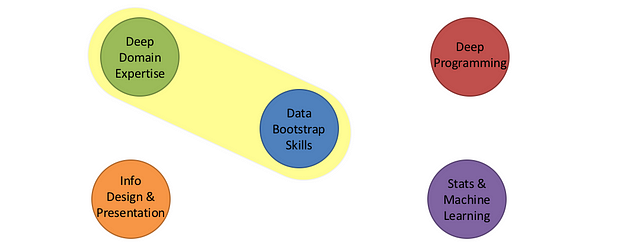
Functional data consultant — Skill mix
Functional data consultants act as a bridge between business users and the data science team, by combining their domain mastery with the essential data skills. Acting as a strong influence in the team, they onboard clients on data-driven use cases, while keeping the analytics solution business-driven and actionable.
Transforming into a Unicorn in Data science

Making of a unicorn — the secret sauce (Photo by Caroline Attwood on Unsplash)
These 4 key roles in data science show how people from varied backgrounds — programming, statistics, design and domain, can transform their innate skills into an influential role in analytics projects. It’s the strong fundamentals topped up with a passion for data and business application, that makes them invaluable to organisations.
If quality practitioners in these 4 roles are highly sought after in the industry, and in short supply, what then makes a Unicorn in data science? What is that magical mix that can make a person invaluable?
Re-picturing our data science buffet menu, this superior ability is born when one can check off any 3 skills from here, with an exceptional level of mastery in each. As the saying goes, it always looks easier in hindsight. Lets go over a few skill mixes and see the areas where these people can be irreplaceable.
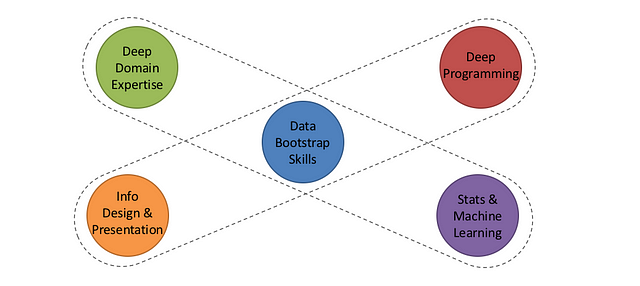
Making of a unicorn — the special mix of skills
- Data bootstrap+ Statistics, ML + Deep programming: An expert who does the heavy-lifting to architect fully packaged data science products.
- Data bootstrap + Statistics, ML + Deep domain: An expert who conceives and prototypes deep, verticalised data science applications.
- Data bootstrap + Info Design + Deep Programming: A master story-teller who delivers delightful data science applications.
- Data bootstrap + Info Design + Deep domain: An expert who runs domain-deep UX consulting to architect enterprise data science apps.
- Data bootstrap + Deep domain + Deep Programming: Attributes of that rare techno-functional data science expert.
As you can see above, the addition of just one more data science skill with a high level of expertise can serve to transform a person’s role. This has a much bigger effect by catapulting a person’s ability, contribution and value out of the park.
You may ask, what if you can rack up 4 or more of these skills? Well, then consider yourself a demi-God in data science. Or, as the famous MasterCard campaign goes, your value in the Data science industry becomes ‘Truly Priceless !’.
Summary
Data science projects need a combination of key skills in order to be successful in solving a client’s problem. Often, company job descriptions for a single position may call out most or all of these skills. Given the huge spread of candidate abilities, this is just an attempt to get as much of an overlap as possible.
One man doesn’t make a team. It takes eleven. — Bear Bryant, legendary football coach
In reality, project teams are dynamically staffed with a varying mix of roles based on the core skill levels of people. There could be analytics initiatives that manage to get this mix amongst 3 people, while others might onboard 5. Usually, organisations prefer smaller teams with interdisciplinary skills, for better coordination and more effective outcomes.
Don’t people enter the industry without the suggested breadth of base data skills, or with a lack of depth in a key skill area? Yes, but then their level of contributions are a shade of others, and it all comes down to a matter of surviving versus flourishing, in the data science field.
The deeper a candidate’s competence in two or more of the above skill areas, better prepared will the person be to make impacting contributions. This consequently translates to higher perceived value and hence much better negotiating power in interviews. To up the game further, one needs to consciously pick another skill and invest in oneself by going really deeper.
For the best return on your money, pour your purse into your head. — Benjamin Franklin
How does this mix of roles and skills align with your world of data science?



